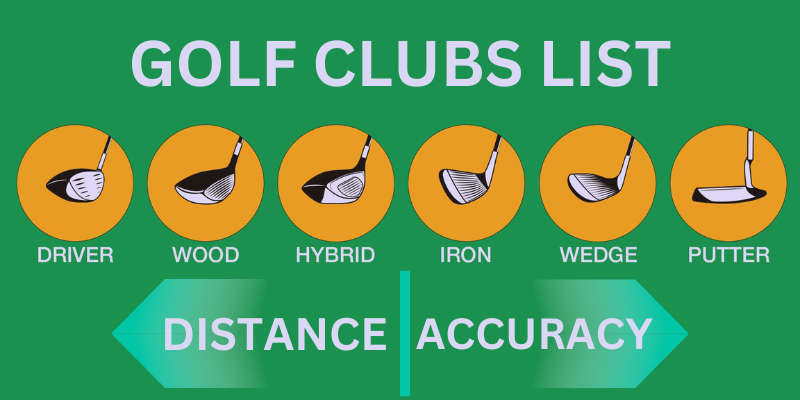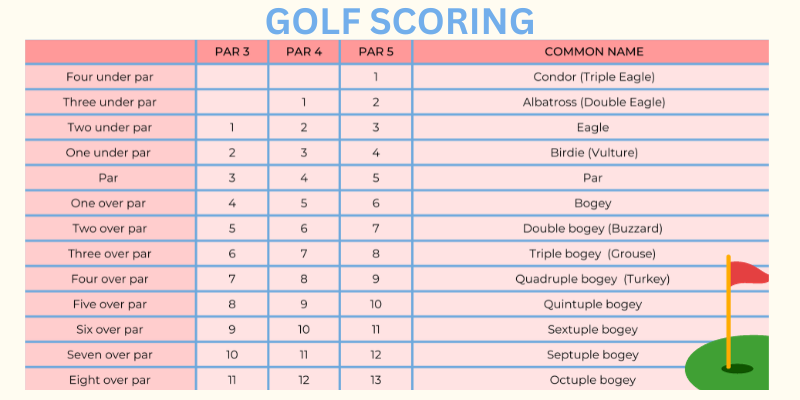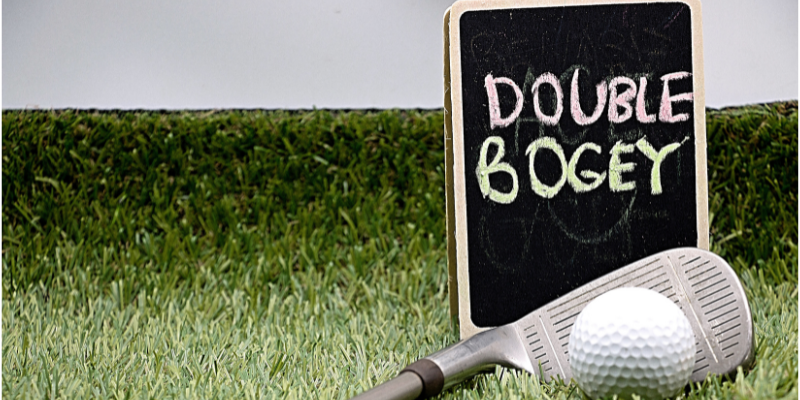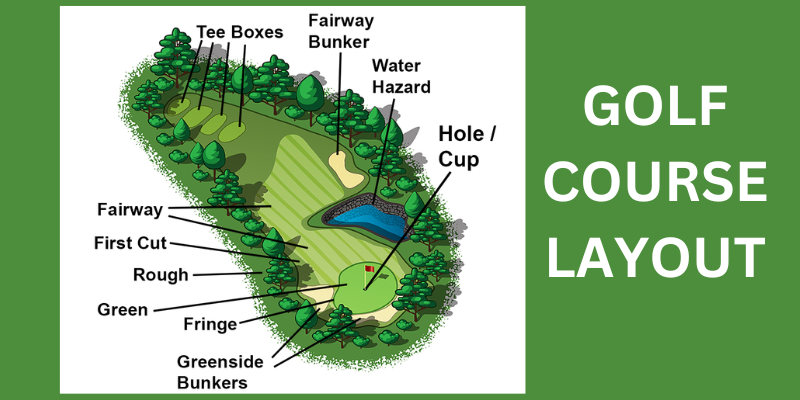In this article, we have prepared the basic golf terms list.
Golf, often described as a game of precision and strategy, comes with unique terminology.
Whether you’re a newcomer to the sport or a seasoned golfer, understanding these basic golf sports terms is essential.
From the “Tee” where it all begins to the “Green” where it all ends, let’s tee off into the world of golf lingo!
Basic Golf Terms List:
- Tee: The small peg on which the golf ball is placed at the beginning of each hole, allowing the golfer to start the hole.
- Rough: The longer grass bordering the fairway, which is more challenging to play from and often punishes inaccurate shots.
- Birdie: Completing a hole in one stroke less than par, indicating a good performance on that hole.
- Eagle: Completing a hole in two strokes less than par, signifying an excellent performance on that hole.
- Handicap: A numerical representation of a golfer’s ability, used for competitive purposes and to level the playing field when golfers of different skill levels compete.
- Stroke Play: A golf format where the total number of strokes a golfer takes is recorded, and the player with the fewest strokes wins.
- Match Play: A golf format where golfers compete hole by hole, and the player or team that wins the most holes wins the match.
- Caddy: A person who carries a golfer’s Different Types Of Golf Clubs, provides advice, and assists during a round.

- Mulligan: A do-over shot, often informally allowed for recreational golfers to take a second attempt without penalty.
- Divot: A piece of turf that is displaced when a golf ball is struck, usually replaced by golfers to maintain the course.
- Putt: A gentle stroke used on the green to roll the ball into the hole, typically performed with a putter club.
- Drive: The first shot taken on a hole, typically the longest shot of the hole, aimed to get the ball as close to the hole as possible.
- Approach Shot: A shot taken to get the ball closer to the green after the drive, often played with an iron club.
- Irons: Golf clubs designed for shorter shots with a higher degree of control, often used for approach shots and shots from the fairway.

- Woods: Golf clubs designed for longer shots, typically used from the tee box or for long fairway shots.
- Putter: A specialized golf club used for putting on the green, designed for precision and control.
- Out of Bounds (OB): Areas on the golf course where a ball is not allowed to be played, often marked by white stakes or lines.
- Scorecard: A card used to keep track of a golfer’s score during a round, recording the number of strokes taken on each hole.

🏌️ What is a golf hole called?
Hole A circular hole in the ground which is also called “the cup”, 4.25 inches in diameter.
🏌️ What are golf teams called?
Single, Twosome, and Foursome. Individual players are referred to as “single”, teams of two are called a “twosome” whereas a team of four is called a “foursome”.
🏌️ What is a bad golf shot called?
Shank – A shot struck on the clubs hosel that travels dead right (for a right-handed player). The shank is typically considered the worst shot in golf.
🏌️ What do you call 18 holes of golf?
A standard round of golf consists of 18 holes, and as such most courses contain 18 distinct holes; however, there are many 9-hole courses and some that have holes with shared fairways or greens.
🏌️ What does P mean in golf?
The P on a golf club stands for pitching wedge, sometimes labelled as PW. The pitching wedge is one of the most favored golf clubs in a player’s bag because of its ease of use and versatility.
Golf Par Terms
- Par: Par is the standard number of strokes that an accomplished golfer is expected to take to complete a hole or an entire round. Each hole on the course is assigned a specific par value, typically 3 (par-3), 4 (par-4), or 5 (par-5), indicating the difficulty and length of the hole.
- Par-3 Hole: A golf hole that is designed to be played in three strokes by an experienced golfer. Par-3 holes are usually shorter and require precision with the tee shot.
- Par-4 Hole: A golf hole that is designed to be played in four strokes by an accomplished golfer. Par-4 holes often require a combination of accuracy and distance off the tee.
- Par-5 Hole: A golf hole that is designed to be played in five strokes by a skilled golfer. Par-5 holes are typically the longest on the course and offer opportunities for players to reach the green in three strokes with powerful shots.

- Par Score: A golfer’s score for a particular hole in relation to the designated par. For example, if a golfer completes a par-4 hole in four strokes, they have scored “par” for that hole.
- Par Round: Completing an entire round of golf with a total score that is equal to the sum of the par values for all the holes is referred to as shooting a “par round.” For instance, on a par-72 course, shooting 72 for 18 holes is a par round.
- Even Par: When a golfer’s total score for a round equals the sum of the par values, they are said to have shot an “even-par” round. This indicates consistent performance matching the course’s expected difficulty.
- Under Par: When a golfer’s total score for a round is lower than the sum of the par values, they are said to have shot “under par.” For example, if a golfer completes a round in 70 strokes on a par-72 course, they are two under par.
- Over Par: When a golfer’s total score for a round exceeds the sum of the par values, they are said to have shot “over par.” If a golfer finishes a round in 75 strokes on a par-72 course, they are three over par.
Golf Terminology For Scoring
- Stroke Play: Stroke play is the most common form of golf competition. In stroke play, each player tallies their total number of strokes taken over the course of the round, and the player with the lowest score wins.
- Hole Score: Your hole score represents the number of strokes it took you to complete an individual hole. This is typically recorded on the scorecard next to each hole’s number.
- Gross Score: The gross score is the total number of strokes a player takes during a round without any adjustments for handicaps or other factors. It reflects your performance on the course as it happened.
- Net Score: The net score is the player’s gross score minus their handicap. Handicap is used to level the playing field in competitions among players of varying skill levels. A lower net score indicates better performance relative to a player’s handicap.
- Birdie: A birdie occurs when a golfer completes a hole in one stroke less than the designated par. For example, sinking the ball in four strokes on a par-5 hole results in a birdie.
- Eagle: Golf terms eagle is an impressive feat where a golfer completes a hole in two strokes less than par. For instance, finishing a par-4 hole in just two strokes is an eagle.
- Bogey: A bogey golf occurs when a golfer completes a hole in one stroke more than the designated par. If a golfer takes five strokes on a par-4 hole, they have scored a bogey.
- Double Bogey: A double bogey indicates that a golfer has taken two strokes more than par on a hole. For example, finishing a par-3 hole in five strokes is a double bogey.

- Triple Bogey: A triple bogey signifies taking three strokes more than par on a hole. For instance, scoring an 8 on a par-5 hole is a triple bogey.
- Hole-in-One: A hole-in-one, often referred to as an “ace,” is the ultimate achievement in golf. It occurs when a golfer sinks the ball into the hole with a single stroke from the tee.
- Stableford Scoring: Stableford scoring is a modified scoring system that awards points based on the number of strokes taken relative to par on each hole. Players earn points for scores below par, zero points for a par score, and lose points for scores over par. The player with the most points at the end of the round wins.
Golf Course Terminology List:
- Tee Box: The designated area where golfers start each hole, with different tee boxes providing varying distances for play based on skill level and gender.
- Fairway: The well-groomed strip of grass leading from the tee box to the green, where golfers aim to hit their shots for better control and distance.
- Green: The finely manicured area surrounding the hole, where golfers use putters to complete the hole.
- Bunker: A sand trap or hazard on the golf course, typically filled with sand, strategically placed to challenge golfers who land their balls in them.
- Rough: The longer grass surrounding the fairway, which is more challenging to play from and penalizes errant shots.
- Hazard: Any obstacle on the golf course that can negatively impact a golfer’s score, such as water hazards (ponds, creeks) and bunkers.
- Water Hazard: A hazard filled with water, such as a pond or stream, that can pose additional challenges for golfers.

- Cart Path: The designated path or road on the golf course where golf carts are allowed to travel, helping to preserve the turf.
- Putting Green: The closely mowed area surrounding the hole, where golfers use putters to complete the hole.
- Fringe: The transitional area around the putting green, with slightly longer grass than the green itself.
- Pin or Flagstick: The marker located in the hole on the green, usually topped with a flag to indicate the hole’s position.
- Green Speed: The pace at which the ball rolls on the putting green, determined by the length of the grass and course maintenance.
- Tee Markers: Objects or markers that indicate where golfers should tee off, often color-coded to designate different tee boxes.
- Yardage Marker: Signage or markers on the course that provide distance information to various points on the hole, helping golfers gauge their shots.
- Hole Number: Indicates which hole golfers are currently playing; typically found on tee boxes and scorecards.
- Dogleg: A hole that bends or curves in one or more directions, often requiring strategic shot placement to navigate.
- Fairway Bunker: A bunker located within the fairway, making it challenging to reach the green with the next shot.
- Cart Path Only: A rule indicating that golf carts must remain on designated cart paths due to wet or fragile course conditions to protect the turf. If you want to know more about regulations, read our article about Golf Etiquette Rules.
- Greenkeeper or Course Superintendent: The person responsible for the maintenance and care of the golf course, including mowing, landscaping, and overall course conditions.

- Tee Time: The scheduled time at which a group of golfers is expected to start their round, helping to manage course traffic.
- Signature Hole: A particularly picturesque or challenging hole on a golf course, often used for promotional purposes to showcase the course’s unique features.
- Greenside Bunker: A bunker located near the green, which requires precise shots for successful recovery when a golfer’s ball lands in it.
- Tee Box Markers: Objects or signs that indicate the yardage and tee box location for each hole, helping golfers choose the appropriate starting point.
- Water Fountain: A source of drinking water typically found
Why Does Knowing Golf Terminology Matter?
Golf terms are vital for an enriched golfing experience.
They facilitate effective communication among players, ensure adherence to rules during matches, and foster a sense of belonging within the vibrant golfing community.
Understanding golf terminology significantly enhances your enjoyment and participation in the sport.
Conclusion
In conclusion, this exploration of the basic golf terms list has provided valuable insight into the language of golf.
Whether you’re just starting or already well-acquainted with the game, these fundamental golf slang are essential for enjoying and understanding golf.
Happy golfing!